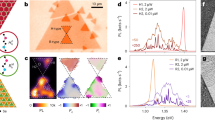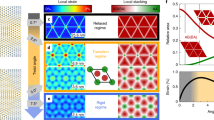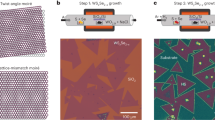Abstract
Moiré superlattices formed by stacking two-dimensional crystals have reinvigorated the pursuit for emergent functionalities of engineered superlattices. Unique optical characteristics can be realized from the interplay between the electronic excitations and the atomic rearrangements owing to their intrinsic softness. Although large-scale reconstructions have been identified at small twist angles, they have been treated as being rigid at large twist angles. Here, we report that moiré superlattices made from single layers of MoS2 and WSe2 exhibit a pair of torsional strains with opposite chirality irrespective of the twist angle. The whirlpool-shaped periodic lattice distortions introduce fuzziness in the Raman spectra and universal redshifts to the intralayer excitons for all twist angles. We show that both of these modulations become weaker as the twist angle increases but do not disappear, whereas they are turned off when the constituent layers are not tightly coupled, thus establishing an essential structure–property relationship for moiré superlattices.
This is a preview of subscription content, access via your institution
Access options
Access Nature and 54 other Nature Portfolio journals
Get Nature+, our best-value online-access subscription
$29.99 / 30 days
cancel any time
Subscribe to this journal
Receive 12 print issues and online access
$259.00 per year
only $21.58 per issue
Buy this article
- Purchase on Springer Link
- Instant access to full article PDF
Prices may be subject to local taxes which are calculated during checkout





Similar content being viewed by others
Data availability
The data that support the plots within this paper, and other findings of this study, are available from the corresponding authors upon reasonable request. Source data are provided with this paper.
References
Esaki, L. & Tsu, R. Superlattice and negative differential conductivity in semiconductors. IBM J. Res. Dev. 14, 61–65 (1970).
Tsu, R. Superlattice to Nanoelectronics (Elsevier, 2005)
Park, C.-H., Yang, L., Son, Y.-W., Cohen, M. L. & Louie, S. G. Anisotropic behaviours of massless Dirac fermions in graphene under periodic potentials. Nat. Phys. 4, 213–217 (2008).
Cao, Y. et al. Unconventional superconductivity in magic-angle graphene superlattices. Nature 556, 43–50 (2018).
Cao, Y. et al. Correlated insulator behaviour at half-filling in magic-angle graphene superlattices. Nature 556, 80–84 (2018).
Andrei, E. Y. et al. The marvels of moiré materials. Nat. Rev. Mater. 6, 201–206 (2021).
Kunstmann, J. et al. Momentum-space indirect interlayer excitons in transition-metal dichalcogenide van der Waals heterostructures. Nat. Phys. 14, 801–805 (2018).
Wilson, N. R. et al. Determination of band offsets, hybridization, and exciton binding in 2D semiconductor heterostructures. Sci. Adv. 3, e1601832 (2017).
van der Zande, A. M. et al. Tailoring the electronic structure in bilayer molybdenum disulfide via interlayer twist. Nano Lett. 14, 3869–3875 (2014).
Waters, D. et al. Flat bands and mechanical deformation effects in the moiré superlattice of MoS2-WSe2 heterobilayers. ACS Nano 14, 7564–7573 (2020).
Zhang, C. et al. Interlayer couplings, moiré patterns, and 2D electronic superlattices in MoS2/WSe2 hetero-bilayers. Sci. Adv. 3, e1601459 (2017).
Tran, K. et al. Evidence for moiré excitons in van der Waals heterostructures. Nature 567, 71–75 (2019).
Yu, H. et al. Moiré excitons: from programmable quantum emitter arrays to spin–orbit coupled artificial lattices. Sci. Adv. 3, e1701696 (2017).
Castellanos-Gomez, A. et al. Deterministic transfer of two-dimensional materials by all-dry viscoelastic stamping. 2d Mater. 1, 011002 (2014).
Li, Y. et al. Probing symmetry properties of few-layer MoS2 and h-BN by optical second-harmonic generation. Nano Lett. 13, 3329–3333 (2013).
Ribeiro-Soares, J. et al. Group theory analysis of phonons in two-dimensional transition metal dichalcogenides. Phys. Rev. B 90, 115438 (2014).
Lui, C. H. et al. Observation of interlayer phonon modes in van der Waals heterostructures. Phys. Rev. B 91, 165403 (2015).
Lin, K. et al. Large‐scale mapping of moiré superlattices by hyperspectral Raman imaging. Adv. Mater. 33, 2008333 (2021).
Lee, J.-U., Park, J., Son, Y. W. & Cheong, H. Anomalous excitonic resonance Raman effects in few-layered MoS2. Nanoscale 7, 3229–3236 (2015).
Kim, S., Kim, K., Lee, J. & Cheong, H. Excitonic resonance effects and Davydov splitting in circularly polarized Raman spectra of few-layer WSe2. 2d Mater. 4, 045002 (2017).
Lee, C. et al. Anomalous lattice vibrations of single- and few-layer MoS2. ACS Nano 4, 2695–2700 (2010).
Debnath, R. et al. Evolution of high-frequency Raman modes and their doping dependence in twisted bilayer MoS2. Nanoscale 12, 17272–17280 (2020).
Mohiuddin, T. M. G. et al. Uniaxial strain in graphene by Raman spectroscopy: G peak splitting, Grüneisen parameters, and sample orientation. Phys. Rev. B 79, 205433 (2009).
Conley, H. J. et al. Bandgap engineering of strained monolayer and bilayer MoS2. Nano Lett. 13, 3626–3630 (2013).
Lee, J.-U. et al. Strain-shear coupling in bilayer MoS2. Nat. Commun. 8, 1370 (2017).
Dadgar, A. M. et al. Strain engineering and Raman spectroscopy of monolayer transition metal dichalcogenides. Chem. Mater. 30, 5148–5155 (2018).
Uchida, K., Furuya, S., Iwata, J.-I. & Oshiyama, A. Atomic corrugation and electron localization due to moiré patterns in twisted bilayer graphenes. Phys. Rev. B 90, 155451 (2014).
Wijk, M. M., van, Schuring, A., Katsnelson, M. I. & Fasolino, A. Relaxation of moiré patterns for slightly misaligned identical lattices: graphene on graphite. 2d Mater. 2, 034010 (2015).
Nam, N. N. T. & Koshino, M. Lattice relaxation and energy band modulation in twisted bilayer graphene. Phys. Rev. B 96, 075311 (2017).
Naik, M. H. & Jain, M. Ultraflatbands and shear solitons in moiré patterns of twisted bilayer transition metal dichalcogenides. Phys. Rev. Lett. 121, 266401 (2018).
Vitale, V., Atalar, K., Mostofi, A. A. & Lischner, J. Flat band properties of twisted transition metal dichalcogenide homo- and heterobilayers of MoS2, MoSe2, WS2 and WSe2. 2d Mater. 8, 045010 (2021).
Yoo, H. et al. Atomic and electronic reconstruction at the van der Waals interface in twisted bilayer graphene. Nat. Mater. 18, 448–453 (2019).
Weston, A. et al. Atomic reconstruction in twisted bilayers of transition metal dichalcogenides. Nat. Nanotechnol. 15, 592–597 (2020).
Rosenberger, M. R. et al. Twist angle-dependent atomic reconstruction and moiré patterns in transition metal dichalcogenide heterostructures. ACS Nano 14, 4550–4558 (2020).
Overhauser, A. W. Observability of charge-density waves by neutron diffraction. Phys. Rev. B 3, 3173–3182 (1971).
Raja, A. et al. Coulomb engineering of the bandgap and excitons in two-dimensional materials. Nat. Commun. 8, 15251 (2017).
Blase, X., Duchemin, I., Jacquemin, D. & Loos, P.-F. The Bethe–Salpeter equation formalism: from physics to chemistry. J. Phys. Chem. Lett. 11, 7371–7382 (2020).
Arjona, V. & Vozmediano, M. A. H. Rotational strain in Weyl semimetals: a continuum approach. Phys. Rev. B 97, 201404 (2018).
Troullier, N. & Martins, J. L. Efficient pseudopotentials for plane-wave calculations. Phys. Rev. B 43, 1993–2006 (1991).
Sánchez-Portal, D., Ordejón, P., Artacho, E. & Soler, J. M. Density-functional method for very large systems with LCAO basis sets. Int. J. Quantum Chem. 65, 453–461 (1997).
Togo, A. & Tanaka, I. First principles phonon calculations in materials science. Scr. Mater. 108, 1–5 (2015).
Acknowledgements
This work was supported by the National Research Foundation (NRF) grant funded by the Korean government (MSIT) (2019R1A2C3006189, 2017R1A5A1014862, SRC program: vdWMRC center and 2021R1C1C1010924). Y.-W.S. was partly supported by a KIAS individual grant (no. CG031509). E.K. was supported by a KIAS individual grant (no. CG075002). Computations were supported by the CAC of KIAS.
Author information
Authors and Affiliations
Contributions
H.C. and J.K. conceived the experiment. J.K. prepared the samples and carried out optical measurements. J.J., M.K. and H.Y. carried out the TEM analysis. The spectroscopic data were analysed by H.C. and J.K. Theoretical analyses were done by E.K. and Y.-W.S. All the authors discussed the results and wrote the manuscript together.
Corresponding authors
Ethics declarations
Competing interests
The authors declare no competing interests.
Peer review
Peer review information
Nature Materials thanks Kristiaan De Greve, Ado Jorio and the other, anonymous, reviewer(s) for their contribution to the peer review of this work.
Additional information
Publisher’s note Springer Nature remains neutral with regard to jurisdictional claims in published maps and institutional affiliations.
Extended data
Extended Data Fig. 1 Twist-angle dependence of Raman spectra.
Compilation of Raman spectra for all samples measured.
Extended Data Fig. 2 Twist-angle dependence of ILB and force constant.
Twist-angle dependence of the ILB mode frequency (a) and force constant between MoS2 and WSe2 layers (b).
Extended Data Fig. 3 In-plane displacement vector dv (red arrows) of the atoms in MoS2 of the model HS with respect to the twist angle.
The pink circle and red circle denote S and Mo atoms, respectively. The magnitude of dv (length of the red arrow) is enlarged from one hundred times to three hundred times as indicated.
Extended Data Fig. 4 Electron diffraction and DF analysis of the lattice modulation.
a, SAED pattern of a MoS2/WSe2 HS with a twist angle of 1.0°. b,d,f, g = \(11\bar 20\), \(\bar 12\bar 10\), \(\bar 2110\) DF images obtained by selecting electron diffraction peaks marked with dashed squares in a. c,e,g are fast-Fourier-transforms (FFT) of the DF images shown in b,d,f, respectively. The peaks marked with black dashed circles in FFTs correspond to the frequency component of 0.25 nm−1. Such frequency is associated with the moiré fringe obtained by simply interfering two sets of {\(11\bar 20\)} planes of MoS2 and WSe2 twisted with 1.0°. The other set of peaks marked with red dashed circles correspond to the frequency of 0.14 nm−1 that are associated with the periodic structures visualized due to the lattice modulation at the interface.
Supplementary information
Supplementary Information
Supplementary Figs. 1–17, Tables 1–3 and Note 1.
Source data
Source Data Fig. 1
Spectra.
Source Data Fig. 2
Spectra and spectral parameters extracted from spectra.
Source Data Fig. 3
Calculation results.
Source Data Fig. 5
Spectra and spectral parameters extracted from spectra.
Source Data Extended Data Fig. 1
Spectra.
Source Data Extended Data Fig. 2
Spectral parameters extracted from spectra.
Source Data Extended Data Fig. 3
Calculation results.
Rights and permissions
About this article
Cite this article
Kim, J., Ko, E., Jo, J. et al. Anomalous optical excitations from arrays of whirlpooled lattice distortions in moiré superlattices. Nat. Mater. 21, 890–895 (2022). https://doi.org/10.1038/s41563-022-01240-2
Received:
Accepted:
Published:
Issue Date:
DOI: https://doi.org/10.1038/s41563-022-01240-2
This article is cited by
-
Visualizing the structural evolution of individual active sites in MoS2 during electrocatalytic hydrogen evolution reaction
Nature Catalysis (2024)
-
Nonlinear optics of two-dimensional heterostructures
Frontiers of Physics (2024)
-
Localization-enhanced moiré exciton in twisted transition metal dichalcogenide heterotrilayer superlattices
Light: Science & Applications (2023)
-
Pressure tuning of minibands in MoS2/WSe2 heterostructures revealed by moiré phonons
Nature Nanotechnology (2023)
-
Twistronics and the small-angle magic
Nature Materials (2022)



